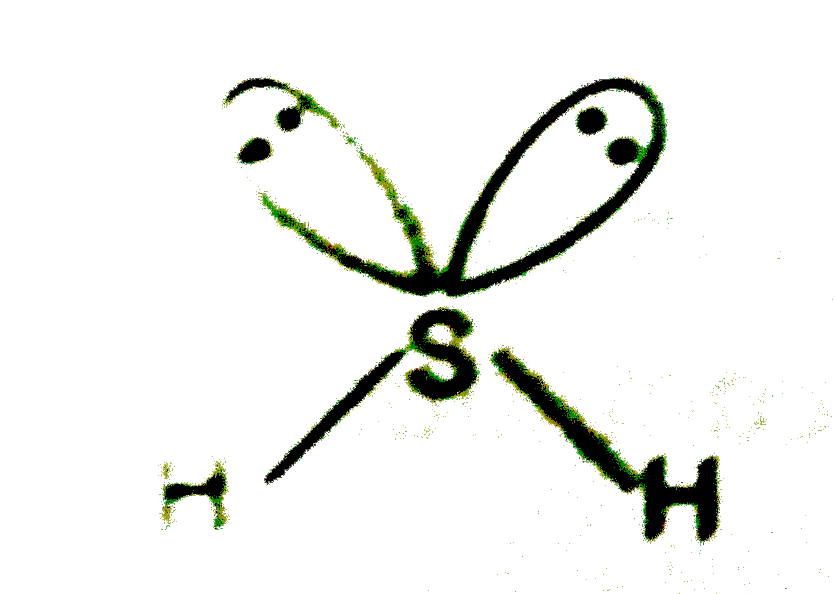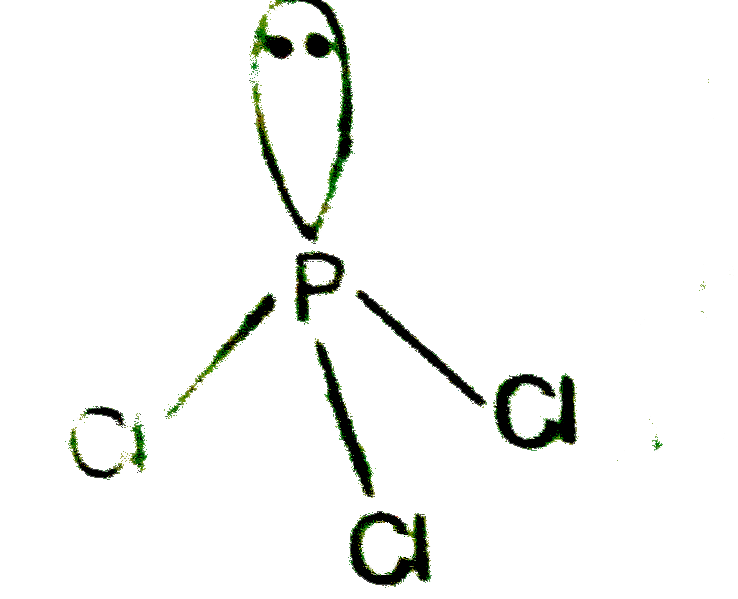Interpret the non-linear shape of H2S molecule and non-planar shape of PCl3 using valence shell electron pair repulsion (VSEPR) theory.
(Atomic number :H=1,P=15,S=16,Cl=17)
Central atoms of H2 is S. There are 6 electrons in its valence shell(.16S=2,8,6) Two electrons are shared with two H-atoms and the remaining four electrons are present as two lone pairs.

Hence, total pairs of electrons are four (2 bond pairs and 2 lone pairs). Due to the presence of 2 lone pairs the shape becomes distorted tetrahedral or angular or bent (non-linear).

PCl3 - Central atom is phosphorous. There are 5 electrons in the valence shell (.15P=2,8,5). Three electrons are shared with three Cl-atoms and the remaining two electrons are present as one lone pair.
Hence, total pairs of electrons are four (1 lone pair and 3 bond pairs). Due to the presence of one lone pair, the shape becomes pyramidal (non-planar).
Topper's Solved these Questions
- CHEMICAL BONDING AND MOLECULAR STRUCTUREBook:NCERT EXEMPLARChapter:CHEMICAL BONDING AND MOLECULAR STRUCTUREExercise:Matching the columns
Explore 5 Videos
- CHEMICAL BONDING AND MOLECULAR STRUCTUREBook:NCERT EXEMPLARChapter:CHEMICAL BONDING AND MOLECULAR STRUCTUREExercise:Assertions and Reasons
Explore 3 Videos
- CHEMICAL BONDING AND MOLECULAR STRUCTUREBook:NCERT EXEMPLARChapter:CHEMICAL BONDING AND MOLECULAR STRUCTUREExercise:Long Answer type questions
Explore 9 Videos
- CLASSIFICATION OF ELEMENTS AND PERIODICITY IN PROPERTIES.Book:NCERT EXEMPLARChapter:CLASSIFICATION OF ELEMENTS AND PERIODICITY IN PROPERTIES.Exercise:Long answer types question
Explore 7 Videos
Similar Questions
Knowledge Check
The shape of ClO−3 according to valence shell electron pair repulsion theory will be
APlanar triangleBPyramidalCTetrahedralDSquare planar.The approximate shape of a molecule can often be predicted by using what is called the valence-shell electron-pair repulsion (VSEPR) model. Electrons in bonds and in lone pairs can be thought of a ''charge cloud'' that repel one another nad stay as far apart as possible, thus causing molecules to assume specific shapes.
The repulsive interactions of electron pairs decrease in the order:
Lone pair - Lone pair gt Lone pair - Bond pair gt Bond pair - Bond pair
These repulsive effects result in deviations from idealised shapes and alteration in bond angles in molecules.
Which among the following molecules have sp3d hybridization with one lone pair of electron on the central atom?
(P) SF4
(Q) [PCl4]+
(R) XeO2F2
(S) ClOF3AP, Q and R onlyBP, R and S onlyCP and Q onlyDQ and R onlyThe approximate shape of a molecule can often be predicted by using what is called the valence-shell electron-pair repulsion (VSEPR) model. Electrons in bonds and in lone pairs can be thought of a ''charge cloud'' that repel one another nad stay as far apart as possible, thus causing molecules to assume specific shapes.
The repulsive interactions of electron pairs decrease in the order:
Lone pair - Lone pair gt Lone pair - Bond pair gt Bond pair - Bond pair
These repulsive effects result in deviations from idealised shapes and alteration in bond angles in molecules.
Molecular shape of XeF+3,SF+3andCF+3 are :AThe same with 2, 1 and 0 lone pair of electrons respectivelyBDifferent with 2, 1 and 0 lone pair of electrons respectivelyCDifferent with 0, 1 and 2 lone pair of electrons respectivelyDThe same with 2,0 and 1 lone pair of leectrons respectively
The approximate shape of a molecule can often be predicted by using what is called the valence-shell electron-pair repulsion (VSEPR) model. Electrons in bonds and in lone pairs can be thought of a ''charge cloud'' that repel one another nad stay as far apart as possible, thus causing molecules to assume specific shapes.
The repulsive interactions of electron pairs decrease in the order:
Lone pair - Lone pair gt Lone pair - Bond pair gt Bond pair - Bond pair
These repulsive effects result in deviations from idealised shapes and alteration in bond angles in molecules.
Which of the following statement is correct with respect ot bond angles?
View SolutionThe approximate shape of a molecule can often be predicted by using what is called the valence-shell electron-pair repulsion (VSEPR) model. Electrons in bonds and in lone pairs can be thought of a ''charge cloud'' that repel one another nad stay as far apart as possible, thus causing molecules to assume specific shapes.
The repulsive interactions of electron pairs decrease in the order:
Lone pair - Lone pair gt Lone pair - Bond pair gt Bond pair - Bond pair
These repulsive effects result in deviations from idealised shapes and alteration in bond angles in molecules.
Which of the following statements is incorrect?
View SolutionThe approximate shape of a molecule can often be predicted by using what is called the valence-shell electron-pair repulsion (VSEPR) model. Electrons in bonds and in lone pairs can be thought of a ''charge cloud'' that repel one another nad stay as far apart as possible, thus causing molecules to assume specific shapes.
The repulsive interactions of electron pairs decrease in the order:
Lone pair - Lone pair gt Lone pair - Bond pair gt Bond pair - Bond pair
These repulsive effects result in deviations from idealised shapes and alteration in bond angles in molecules.
Among the following molecules.
(P) XeO3 (Q)XeOF4
(R) XeO2F2 (S)XeF5
Those having different molecular geometry but same number of lone pairs on Xe are :
View SolutionThe space model which is obtained by joining the points representing various bonded atoms gives the shape of the molecule. The geometry of the molecule is definite relative arrangement of the bonded atoms in a molecule. The shape and geometry of a molecule is explained by valence shell electron pair repulsion theory given by Gillespie and Nyholm.
Which molecule has both shape and geometry identical ?
(I)SnCl2 (II)NH3 (III)PCl5 (IV)SF6
View SolutionThe space model which is obtained by joining the points representing various bonded atoms gives the shape of the molecule. The geometry of the molecule is definite relative arrangement of the bonded atoms in a molecule. The shape and geometry of a molecule is explained by valence shell electron pair repulsion theory given by Gillespie and Nyholm.
Which molecule has both shape and geometry identical ?
(I)SnCl2 (II)NH3 (III)PCl5 (IV)SF6
View Solution

